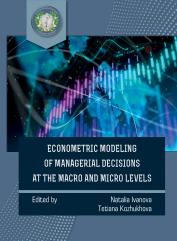CHAPTER 2 Quantitative crisis analysis: identifying and defining imbalances
Ключові слова:
Managerial decision, Managerial decision, managerial decision making model, managerial decision making model, managerial decision making mechanism, managerial decision making mechanism, crisis, crisis, macroeconomic imbalances, macroeconomic imbalances, problem, problem, econometric approach, econometric approach, data-driven decision-making, data-driven decision-making, Highest Paid Person's Opinion, Highest Paid Person's Opinion, data-driven decision making capability, data-driven decision making capability, nformation and analytical support of managerial decisions, nformation and analytical support of managerial decisions, regression model, regression model, econometrics, econometrics, canonical analysis, canonical analysis, taxonomic analysis, taxonomic analysis, cluster analysis, cluster analysis, principal component method, principal component method, tree of opportunities, tree of opportunities, migration policy, migration policy, economic security, economic security, innovative development, innovative development, living standards of the population, living standards of the population, innovation infrastructure, innovation infrastructure, development management, development management, local development strategies, local development strategies, regional tourism markets services, regional tourism markets services, tourism, tourism, hotel and restaurant industry, hotel and restaurant industry, personnel innovation potential, personnel innovation potential, strategic management, strategic management, cognitive model, cognitive model, strategic process concept, strategic process concept, strategic decision, strategic decision, strategic change, strategic change, SWOT analysis, SWOT analysis, Potential square, Potential square, competitiveness, competitiveness, efficiency, efficiencyАнотація
Присвячено дослідженню можливості застосування інструментів кількісного аналізу для визначення макроекономічних дисбалансів як потенціальних провісників поширення кризи. Наголошено, що в сучасних умовах швидкого перебігу кризових ситуацій доцільним є застосування нелінійних моделей, прикладом яких є непараметричні моделі на основі сигнального підходу, що передбачають використання макропоказників (індикаторів), які характеризують стійкість економіки до криз. Для прогнозування виникнення негативних тенденцій розвитку економіки в майбутньому авторами розроблена і запропонована для використання регресійна модель з результативними показниками, що відображає залежність імовірності настання періоду «криза» від ряду економічних індикаторів та здійснена її апробація для економіки України. Результати прогнозування на 2021–2022 рр. дали можливість визначити відхилення економіки України від траєкторії стабільного розвитку. Авторами окреслені коригуючі заходи економічної політики з боку органів макроекономічного регулювання з метою призупинення інерційного розвитку прогнозної ситуації.

ECONOMETRIC MODELING OF MANAGERIAL DECISIONS AT THE MACRO AND MICRO LEVELS
##submission.downloads##
Опубліковано
Ліцензія

Ця робота ліцензується відповідно до Creative Commons Attribution 4.0 International License.
